Liquid-Mirror Telescopes
By Paul Hickson
An old idea for astronomical imaging is undergoing a technology-driven renaissance
An old idea for astronomical imaging is undergoing a technology-driven renaissance

DOI: 10.1511/2007.65.216
Nestled in the mountains of southwestern British Columbia is a nondescript building that might easily be mistaken for a church or a ski chalet. Little about its appearance would suggest that hidden within is one of the largest astronomical telescopes in North America. Yet on clear nights, the steeply sloping roof rolls back, allowing the telescope to record images of the stars and galaxies passing overhead. More remarkable, however, is the fact that the heart of this telescope—the primary mirror, which collects and focuses light—is a rotating dish of liquid mercury.
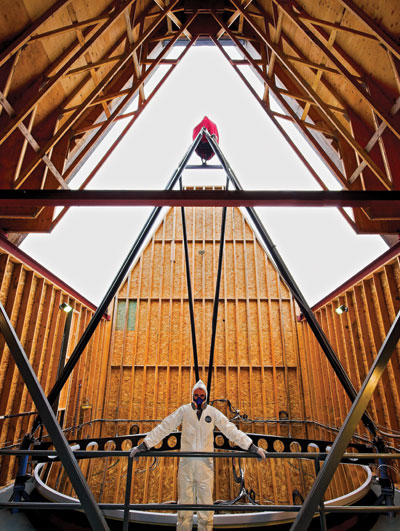
Michael Desjardins
Conventional astronomical telescopes, of course, employ glass mirrors for this purpose. The largest, the Keck twin 10-meter telescopes atop Mauna Kea in Hawaii, actually use segmented primary mirrors, each composed of 36 hexagonal elements. These mirrors must be carefully ground and polished, to an accuracy of a few tens of nanometers, before being coated with a thin layer of aluminum or silver to make them reflective. Such mirrors also require a complex support system to prevent temperature changes or the force of gravity from distorting the surface. And for most large, modern telescopes, a system of sensors and actuators actively controls the shape of the mirror on a fine scale so as to counteract the distortions created by the atmosphere, a strategy dubbed "adaptive optics." These instruments are technological marvels, but they cost an enormous amount to build, roughly $10 million for one with a 6-meter-diameter mirror. Amazingly, comparable precision can be achieved simply by rotating a dish covered with mercury.
The principle is elementary and known to all first-year physics students. The surface of a liquid in equilibrium is a surface of constant potential energy. (Any variation of the potential along the surface would constitute a force, which would cause the liquid to flow). Normally, the potential energy of an object is just proportional to its height. So the surfaces of most liquids are flat or essentially so. But suppose that one rotates a liquid at a constant angular speed about a vertical axis. The potential energy of any tiny parcel of fluid now has two components, one that increases with height and another that decreases with distance from the rotation axis—or rather, with the square of that distance. That particular combination of dependencies makes the surface take on the shape of a paraboloid.
By happy coincidence, a paraboloid is exactly what is needed to focus light. Incident rays that are parallel to the axis are reflected so that they come together at one spot, the focal point of the mirror. Parallel rays arriving from other directions are not focused so perfectly. But with the addition of three or four lenses placed close to the focal point, good image quality can be obtained over an extended field of view. Most large astronomical telescopes thus employ parabolic (or nearly parabolic) primary mirrors and secondary mirrors or lenses to correct off-axis aberrations.
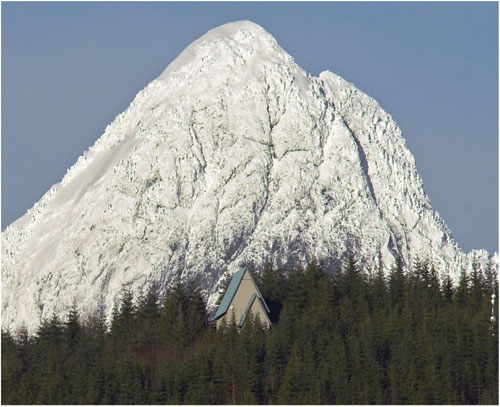
Michael Desjardins
The idea of using a rotating liquid to focus light is an old one. The Italian astronomer Ernesto Capocci of the Osservatorio di Capodimonte in Naples was the first to describe this possibility in print, in 1850, although he never put the idea into practice. The concept was initially demonstrated in 1872, when Henry Skey of the Dunedin Observatory in New Zealand constructed a 35-centimeter-diameter liquid mirror in his laboratory. In 1909, the American physicist Robert W. Wood of Johns Hopkins University built the first complete liquid-mirror telescopes. Wood's most successful model used a mirror that was 51 centimeters in diameter. It rotated on a mechanical bearing and was turned by a motor using a drive belt consisting of fine threads of India rubber. With this telescope, Wood was able to resolve the e Lyrae quadruple star system, which has component stars separated by as little as 2.3 arc-seconds. Such performance is quite impressive—within a factor of 10 of the theoretical diffraction limit for a mirror of that size.
Still, Wood's telescope was not very practical. It was plagued by vibrations and a small but noticeable wobbling of the mirror. What's more, imprecise speed control gave rise to fluctuations of its focal length. Because the rotation axis had to be vertical, the telescope could observe only a small area of sky directly overhead, and the rotation of the Earth resulted in constant motion of the images. Such problems took much of the luster off the idea of using liquid-mirror telescopes for astronomy, which explains why this strategy was abandoned for the next 73 years.
In 1982, Canadian physicist Ermanno F. Borra, working at Laval University in Quebec, decided to revisit the approach Wood had pioneered. Borra and his colleagues realized that modern technology could readily solve the difficulties that Wood had had no way to address during the Edwardian era.
In particular, Borra realized that the problem of the image drifting across the field of view as the Earth turned could be solved by replacing traditional film with a modern detector, a solid-state sensor known as a charge-coupled device (CCD), which is a particular kind of silicon integrated circuit. Photons impinging on the silicon deposit enough energy to boost electrons into the conduction band. These electrons are stored in potential wells created by voltages that are applied to an array of electrodes. Thus, an optical image is converted to an electronic image within the silicon. At the end of an exposure, the shutter is closed and applied voltages are manipulated in such a way as to move the collections of electrons across the face of the device to one side and from there bucket-brigade style to an output amplifier that produces a series of voltage signals, each proportional to the number of electrons that were collected in each potential well. In this way, the image is read out one pixel at a time to a computer where it can be stored, processed and displayed.
Most of today's digital cameras use CCDs to capture images in this way. When the illumination is low, one simply needs to allow the CCD to gather light for a longer interval before the shutter is closed. Unfortunately, this tactic will not work with a liquid-mirror telescope, which cannot track a celestial object as it moves through the sky. If the CCD was used in the usual way, star images would appear as streaks rather than as sharp points.
Charge-coupled devices can, however, be operated in a different manner, by manipulating the applied voltages so as to shift the electronic image to the side of the chip during the exposure. By aligning the direction of shift with the direction in which the projected starlight is moving and by applying voltages to the CCD electrodes at the appropriate rate, one can coax electrons along at the same speed as the drifting image. If that shifting is done properly, there is no blurring, because the electrons keep pace with the photons that are producing them.
When a star image reaches the edge of the CCD, so do the corresponding electrons, which are then transferred to the amplifier that measures them. No shutter is needed because the readout takes place continuously, typically at the rate of some tens of lines per second. The effective exposure duration is the time that it takes for a star image to drift across the face of the CCD, typically one or two minutes. Astronomers often use this tactic, called "drift scanning," when they make observations with conventional telescopes, because it provides a very efficient way to image a large area of sky.
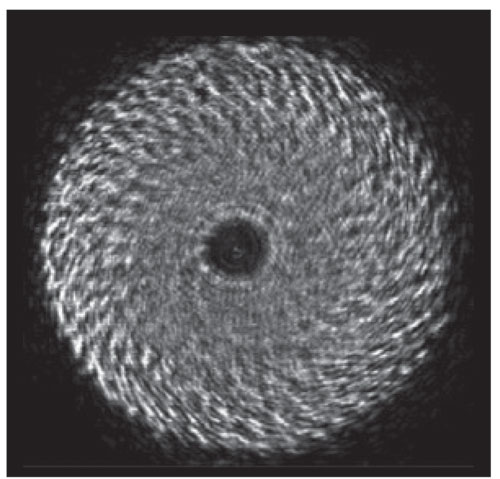
Image courtesy of Ermanno F. Borra, University of Laval.
Although the prospect of drift scanning inspired Borra to revive the idea of liquid-mirror telescopes, he never progressed to the point of employing this technique. He did, however, introduce other innovations. To overcome vibration and wobble, Borra employed an air bearing, which has precisely ground surfaces separated by a thin film of pressurized air. Such bearings are virtually frictionless and can thus provide very smooth rotation. Using a synchronous motor driven by a crystal-controlled oscillator, Borra also eliminated the speed variations that had plagued Wood's instrument.
In less than a decade, Borra and his colleagues had built mercury mirrors as large as 1.5 meters in diameter; they would later go on to build one that was 3.7 meters across. These mirrors had surfaces of very high optical quality. Indeed, Borra and his team were able to obtain diffraction-limited images from these mirrors in the laboratory—that is, ones that were as sharp as is theoretically possible for an optical element of that size. And Borra used some of his mirrors to make astronomical observations in combination with a 35-millimeter film camera.
These efforts attracted the attention of other astronomers, including me. After much work, my colleagues and I demonstrated the first truly practical liquid-mirror telescope, one that took advantage of drift scanning, in 1994. That instrument employed a 2.7-meter-diameter mercury mirror, a four-element lens for correcting off-axis distortion and a CCD camera. With this telescope, we obtained digital images of stars and galaxies at a resolution that was limited only by what astronomers call "seeing" (blurring from atmospheric turbulence)—not by imperfections in the liquid mirror. This telescope was soon followed by three others, two being used for laser investigations of Earth's atmosphere and the third, the 3-meter NASA Orbital Debris Observatory (which operated in New Mexico through 2002), for studies of "space junk."
Building on this experience (and on some skills I had picked up in my spare time constructing experimental aircraft), in 2005 my coworkers and I fabricated a 6-meter mirror for an instrument we dubbed the Large Zenith Telescope (LZT). The aim of this project was to develop and perfect liquid-mirror technology on a scale competitive with the largest conventional astronomical telescopes. Of course, the inability to look in any direction other than straight up (the zenith) means that such telescopes will never replace their conventional counterparts, which can point to just about any part of the sky.
But this lack of flexibility is not quite so limiting as you might think. For a large number of scientific studies, fixed pointing is not a hindrance. If the aim is to determine the statistical properties of a large number of objects, say distant galaxies, it often does not matter what part of the sky you probe. One finds distant galaxies everywhere, and the zenith is as good a place as anywhere else to look. Indeed, it is the best place to direct your telescope because it offers the least amount of air in the light path and hence the least amount of atmospheric absorption, scattering and image distortion.
For such research programs, liquid-mirror telescopes serve just as well as conventional telescopes but don't cost nearly as much. The LZT was built for less than $1 million—an order of magnitude lower than what one would spend for a conventional telescope of comparable size. So if some of the funds slated for the construction of telescopes were channeled into instruments that use liquid mirrors, astronomers doing this kind of research could get considerably more observing time.
The success of the LZT did not come easily. We faced countless hurdles, most of them unexpected. Early in the design phase, for example, we discovered that no air bearing in existence was suitable for supporting our 6-meter mirror, so we had to have one built expressly for this unconventional project, which turned out to be no easy feat. It required our contracting with a company in Minneapolis, which managed to put together a unit that could support our 3-ton mirror. Other difficulties ranged from the predictable—equipment failures and problems with overheating or freezing in the pneumatic system that supplies air to the bearing—to the ridiculous, as when a mouse jumped onto the rotating mirror and then ran in circles, breaking the delicate film of mercury, because it was afraid to jump off.
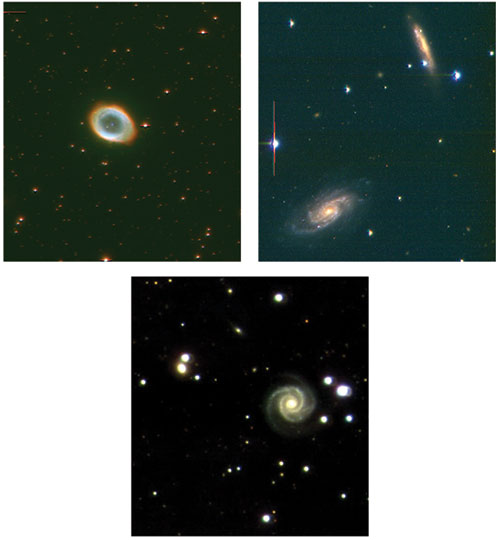
Images at top courtesy of Mark Mulrooney and NASA. Image at bottom courtesy of the author.
Of all the problems we encountered, two were fundamental and required considerable effort to solve. The first was reminiscent of the speed fluctuations that plagued Wood's telescope. Although our mirror is driven by a motor that is synchronized to a highly stable oscillator, there is no rigid coupling between the motor and the mirror. Such a coupling would introduce vibrations. Instead, a ring of permanent magnets is attached to the rotor of the air bearing, the part that supports the giant mirror. These magnets turn within a magnetic field produced by three stationary field windings. By supplying the proper electrical currents to these windings, a rotating magnetic field is generated, which then turns the mirror.
We had thought that the large inertia of our massive mirror would prevent air currents and other disturbances from causing any variation in rotation speed. We were wrong. When we first turned the telescope on, we saw speed variations as large as 0.1 percent when gusts of wind came through the open roof of the observatory building. These variations were 1,000 times larger than the 1-part-per-million stability we were aiming for. Clearly something had to be done.
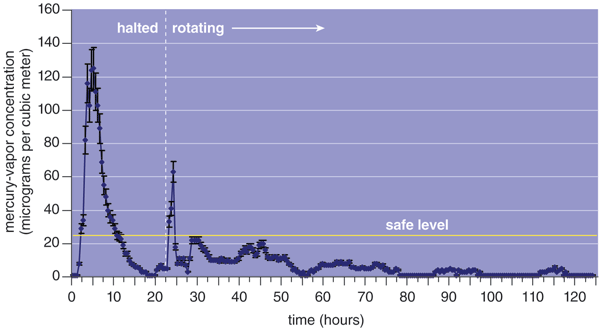
Barbara Aulicino
The solution was to design and build a system that actively stabilizes the rotation speed. As the mirror turns, a device attached to it generates 2,500 precisely spaced pulses for each 360-degree rotation. The control system measures the arrival time of each pulse and compares it with the expected time for a mirror moving at the prescribed speed. If a pulse is late, the mirror must be slowing, so the power supplied to the stationary windings of the motor is increased to compensate. If the pulse comes early, the motor currents are adjusted to slow the motion of the mirror. This approach cured the problem, and the mirror speed is now constant to about one part per million under almost all observing conditions.
We discovered a second, more sinister, problem when we started to record images with the telescope: Every star was surrounded by a diffuse halo of light. The effect had been seen before in the laboratory, but never to such a large extent. Numerous waves propagating on the surface of the mercury were diffracting light and blurring our images. But what was causing the waves?
Some investigation soon revealed the answer. The liquid mirror of the LZT is large and rotates fairly rapidly. The rim of the mirror is moving through the air at a speed of 2.2 meters per second. Thus the mercury on the outside of the mirror sees air moving over it at this rate. As is the case for wind blowing across water, waves are produced.
We tested this theory by probing the air flow close to the surface using a piece of Christmas tree tinsel attached to a wand. Near the center of the mirror, the flow of air was smooth, but beginning at a radius of about one meter, things became turbulent. Spiral vortices were forming less than a centimeter above the mercury, where they were creating the troublesome waves. Careful optical tests confirmed this result.
Our solution was to suspend a very thin film of transparent Mylar plastic a few centimeters above the mercury. This cover rotates with the mirror, trapping the air beneath and forcing it to rotate at the same speed as the mercury. The vortices are still present, but now they are above the plastic and cannot affect the reflective liquid surface. When we added this cover, the waves vanished. The LZT now achieves an image quality comparable with that of the best conventional telescopes.
What does the future hold for liquid-mirror telescopes? Probably a lot. There are two new efforts under way right now. The International Liquid-Mirror Telescope, led by Jean Surdej of the University of Liège in Belgium, will be a 4-meter instrument equipped with a large-format CCD camera. Unlike the LZT, which of necessity had to be built near my university in Vancouver, where observing conditions are poor, the new telescope will be located at a superb site for astronomy on a Chilean mountaintop. The second project, led by Arlin P. S. Crotts of Columbia University, aims to build an 8-meter liquid-mirror telescope, also in Chile. Dubbed the Advanced Liquid-mirror Probe for Astrophysics, Cosmology and Asteroids (ALPACA), this telescope would have a wide 3-degree field of view and be equipped with a drift-scanning camera containing as many as 240 CCDs. With full funding, these instruments could begin operation in as little as three to four years.
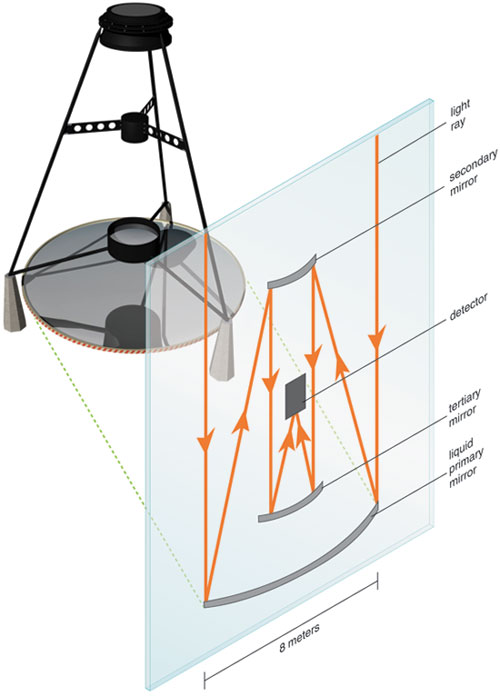
Barbara Aulicino
Further in the future, the possibilities become really intriguing. Using active correcting elements at the focal point, it is possible for liquid-mirror telescopes to follow objects in the sky for as long as 30 minutes. Such tracking capabilities would allow these telescopes to operate at infrared wavelengths, which is impossible at the moment because infrared detector arrays cannot drift-scan. Advanced liquid-mirror telescopes could include adaptive optics to compensate for atmospheric turbulence. Also, it should be possible to combine the light from many separate liquid mirrors, just as is being done now for some conventional telescopes, providing very high sensitivity and resolution.
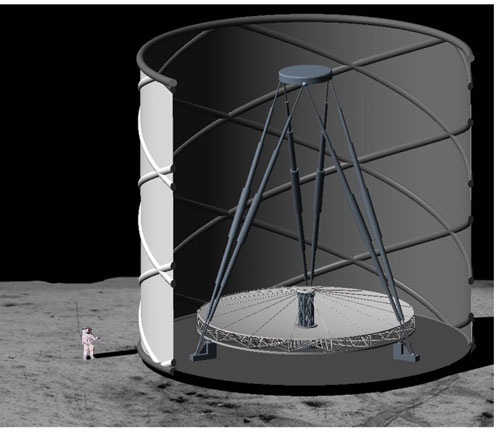
Courtesy of Thomas Connors, Steward Observatory, University of Arizona.
Perhaps the most remarkable idea yet voiced is that of building liquid-mirror telescopes on the Moon. The Moon is an ideal location because of its dark sky, stable gravity and the absence of any atmosphere that might disturb the liquid and distort the images obtained. Located near the Moon's north or south pole, a zenith-pointing telescope could observe the same area of sky for months on end, detecting and studying the most distant and faintest objects in the visible universe. On the Moon, lightweight rotating liquid mirrors could be deployed with diameters perhaps as large as 100 meters. These giant reflectors could not use mercury, which would freeze, but they could employ low-temperature ionic liquids that do not evaporate. The liquid would have to be made reflective by depositing a metallic film on its surface while the mirror is spinning. Because the Moon has no atmosphere, an air bearing would not be practical. Instead, the mirror would probably float on a magnetic field stabilized by superconducting elements.
Far from being a wild dream, the concept of a lunar liquid-mirror telescope has already won NASA support: An international team lead by J. Roger P. Angel of the University of Arizona is currently developing plans for such a powerful instrument. If this concept is carried forward successfully, liquid-mirror telescopes might help usher in a whole new era of astronomical imaging.
Click "American Scientist" to access home page
American Scientist Comments and Discussion
To discuss our articles or comment on them, please share them and tag American Scientist on social media platforms. Here are links to our profiles on Twitter, Facebook, and LinkedIn.
If we re-share your post, we will moderate comments/discussion following our comments policy.